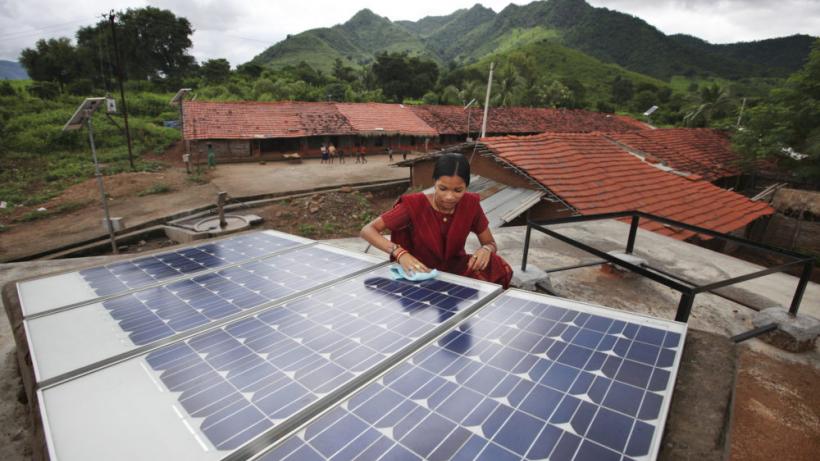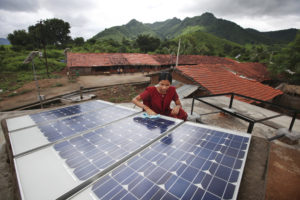
Power politics and energy trade
The Himalayan divide
In early October, the Indian Government declared its intention to sign the Paris Climate deal. By ratifying the agreement on October 2nd, India will always be remembered as a key country that helped push the global climate deal into force. Still, the work of limiting greenhouse gas emissions at a time where the country is growing and modernising rapidly is a colossal task; the burden of which will squarely fall on the power sector.
Mr. Modi has outlined a bold vision for technologies like solar power. But it will still be necessary to leverage the unharnessed hydropower potential of the Himalayas, spread across several national boundaries, to provide clean and reliable energy and to support integration of solar energy. Thus, the development of cross-border hydro projects along with cross-border electricity trade is crucial to produce the magnitude of energy required. This will require significant cooperation among nations with a long history of tension and misgivings. A collaborative effort to achieve climate control targets holds the possibility of bringing them together and changing the political narrative. The existing tensions are deeply held, both between the religious boundaries of Hindu and Muslim, and the geographic ones that culminate in the high mountain landscapes of Kashmir. They manifest most clearly in the Kashmir region, now home to routine anti-militant “surgical strikes”, troop deployment, and the threat of nuclear war.

Power Politics
Across the countries of South Asia – India, Pakistan, Bangladesh, Nepal, Bhutan, and Sri Lanka – there is a struggle to ensure sufficient energy services – both as a foundation of growth and as a means to climb out of severe poverty.
There is a severe power shortage in Pakistan today. Rolling blackouts in cities are a regular and expected occurrence. The power situation is no different in nearby Nepal. Likewise in Bangladesh, the paucity of power remains a core obstacle to growth and prosperity. The need for Bangladesh to quadruple its electricity generating capacity over the next two decades is severely limited by its ability to finance power plants. Additionally, the increasing intensity of floods and storms that frequently ravage Bangladesh render several existing projects at risk. In India, it is a different issue. It is a paradox because a relatively large electricity generation surplus coexists with thousands of villages and hundreds of millions of people still living in darkness. Nevertheless, the energy surplus is a significant silver lining for its neighbors.
This odd surplus – as dubious as it may be – is an inspiring story that started in 2003 when the Indian Parliament passed landmark legislation, replacing the old electricity Act. The new law allowed electricity trade, mandated open access and empowered the electricity regulator to develop an electricity market. Open access materialised on the main transmission grid in 2004 and traders began their work. Power exchanges were set up a few years later in 2007. This happened at a remarkable pace, unprecedented even in most rich countries.
India is so big and diverse in terms of weather that even in an overall shortage scenario there are states or regions with surplus energy, particularly in the East and the North-East. Open access makes the technical (and trickier) part of trading electrical energy relatively simple. The power trade started right in the midst of a nearly 10% energy shortage nationally, baffling the ministry of power.
One of the first energy trade transactions was between the eastern city of Kolkata and the northern state of Punjab over weekends when offices are closed in Kolkata and demand drops. Punjab went further in its quest and started buying power from late night to early morning. No bureaucratic intervention could have caused such an efficient allocation of resources, or could have convinced the business class to invest in generating plants on such a massive scale.
And when the rising prices in the short term electricity market caught the attention of the Indian business class, there was no looking back. Over the last decades, the generating capacity of India sky rocketed by a factor of ~3. Trade volumes in the open market have ballooned to a figure that is more than the total electricity requirement of Bangladesh, Nepal, and Sri Lanka put together.
(Hydro)Power knows no boundaries
Sitting atop the Himalayas, Nepal has massive hydro power potential. However Nepal has exploited less than 1% of its hydro potential, even though brownouts and blackouts are a regular feature of life in the country. At present, Nepal imports power from India through a dozen small cross-border links. Any further progress on strengthening these ties is typically addressed with a deep sense of suspicion. Arguments include: “India buys electricity cheaply from Bhutan and then the same electricity is sold to Bangladesh at double the price. But India doesn't allow Nepal access to sell electricity to Bangladesh.” The fact is that Nepal has no electricity to sell. If Nepal did have a surplus it could be sold into the Indian market, and even to Bangladesh through the same link.
Bhutan too sits high in the mountains of Asia, and knows well the art of living with a big neighbor. The export of hydroelectricity to India constitutes 40% of Bhutan’s national income. Many big hydro projects are now under construction with Indian assistance, and will likely be commissioned by 2018-19. The electricity export to India will then triple. For India, it is an excellent source of reliable, economical and clean energy.
Further south, the India-Sri Lanka feasibility report for a one hundred kilometer submarine cross-border interconnection was completed. However, when the matter of sharing the $650 million investment bill arose, there was stalemate. The project has been buried since then, despite the fact that Sri Lanka generates one third of its power with imported oil.
Bangladesh has played the diplomatic game well. In Dec 2009, the Bangladesh Prime Minister Sheikh Hasina came to India. As a result, an agreement was signed to build a large cross-border power transmission link. Things progressed smoothly, and now Bangladesh imports about 10% of its electricity from India. Another cross-border link is under construction and will be completed by March 2018. Still, Bangladesh generates lots of electricity from oil and diesel at exorbitant cost manifesting in a large drain on the economy. More hydro power from the Himalayas can significantly reduce the necessity of setting up power plants running on imported coal.
In Nov 2014, at a South Asian Association for Regional Cooperation summit held in Kathmandu, a Framework Agreement for Energy Cooperation (Electricity) was signed. The agreement states the SAARC nations shall provide access to the respective transmission grids, and enable cross-border electricity trading. Currently, India is the only country in South Asia which has developed an electricity market and provides access to its national grid to other countries (Nepal, Bhutan and Bangladesh). It is thus rather intriguing that India does allow cross border entities one-to-one electricity trade in the Indian electricity market. However, India does not allow cross border entities to trade on India’s power exchange. The power of integration that India experienced to pull together its ailing power sector not so long ago has not yet been generously extended to its neighbours.
Cricket: bridging trade
Cricket or ping pong matches are good starters for improving relations between nations, but ultimately it is a mutual dependence through trade that will hold the key. In the energy sector, this means cross-border infrastructure. One example comes from the small, wet, island of Ireland. Despite energy not being part of the Peace Agreement between the Catholic South and protestant North, the “all-island market” has become a symbol of political success, and a foundation for strong economies. While concerns about the fungibility of “orange and green electrons” were raised, the religious boundaries were circumvented by the laws of physics. There are likely lessons in this exercise – a technical issue able to be successfully transacted below the radar of religion and politics – for the Muslim-Hindu borders in South Asia.
Had the India-Pakistan power trade agreement been clinched in 2012 or 2013, when they came so close to taking a leap of faith, the subsequent narrative between the two nations might today be very different. As soon as the Indian delegation returned from Islamabad in 2013 with a ray of hope, Hafiz Sayed tweeted in Pakistan: “We don't want electricity from Hindustan (India)” – a network of peace, disrupted by 140 characters.
The choice is simple; let power lines be built , trade grow and jobs opportunities increase. The other options may not be sufficient to contain the trend of increasing frustration and extremist influence on the desperate young generation of South Asian. Opportunities may have been lost, but there is no option but to relentlessly strive to build bridges of roads, wires and power trade in this volatile region and grab opportunities, which come rarely, with both hands.

